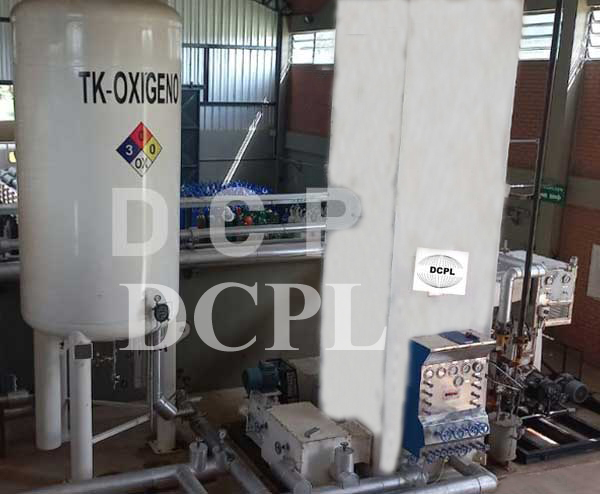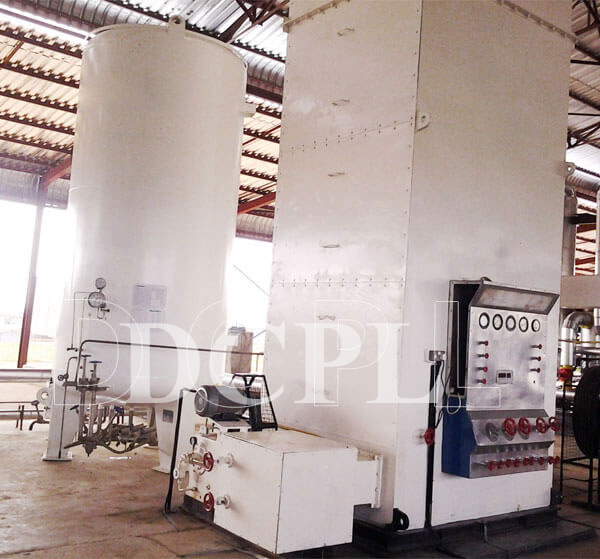Liquid Nitrogen Production Plant
DCPL liquid nitrogen production plant exemplifies efficiency, reliability and uninterrupted generation of liquid nitrogen (LIN). DCPL industrial machinery uses cryogenic distillation technique for liquefaction of atmospheric air for separation of nitrogen from other gases on the basis of their boiling points.
Cryogenic air separation technique is the most commonly used in a wide range of industries. The process was first discovered by a German scientist Dr. Carl von Linde in 1902. By 1930s it has become a preferred choice in industries.
Industries require nitrogen for wide range of applications including manufacturing fertilizers, making chemical products, creating modified atmosphere and many more. Moreover, there is a reason why industries prefer using liquid nitrogen filling plant. Obvious as it is, LIN is easy to store and transport without any leakage unlike gaseous nitrogen.
On the other hand, Liquid nitrogen plant establishment comes with a cylinder filling system with capacities ranging from 833LPM to 4167LPM. The LN2 plant is equipped with a liquid nitrogen pump & a vaporizer to convert liquid nitrogen into gaseous nitrogen. As per their needs, the client can fill nitrogen cylinders or route into a pipeline.


Cryogenic Liquid nitrogen plant(LIN) working principle
Cryogenic air process for producing LIN starts with intake of atmospheric air into the air separation unit. Afterwards, the air is filtered and compressed in the air compressor. Here the compressed air moves into a purification system for cleaning of impurities including carbon dioxide, water content and hydrocarbons. The purification unit has got two molecular sieves for the purpose of cleaning.
Subsequently, the processed air moves through the main heat exchanger cooling it to the cryogenic temperature based on the boiling points of the constituent gases of atmospheric air. Then, it enters the high pressure distillation column for separation of gases. Liquid oxygen is formed at the top of the column and liquid nitrogen at the bottom of the column. LIN is collected as it is the product gas and is further distilled for achieving commercial purity (99.9%).
As mentioned earlier, liquid nitrogen working principle begins with intake of ambient air and ends at storing LIN in a liquid storage tank. However, it must not be forgotten that LN2 factory plant can also generate oxygen with purity up 99.7%.This is the biggest advantage of purchasing an onsite LIN generation plant.
Liquid Nitrogen Plants Specifications
| MODEL | DCPL-50L | DCPL-80L | DCPL-100L | DCPL-150L | DCPL-200L | DCPL-300L | DCPL-400L | DCPL-500L |
|---|---|---|---|---|---|---|---|---|
| Capacity(In Cubic Meter per Hour) | 50 | 80 | 100 | 150 | 200 | 300 | 400 | 500 |
| Liters(Output) | 75 | 120 | 150 | 220 | 280 | 440 | 580 | 725 |
Get Technical Catalogue & Price for Liquid Nitrogen Plant Setup
+91-8448814625
Our Sales Team will provide you with best offers for your needs.
Get QuotesIndustrial uses of liquid nitrogen generator plant
As you might be aware, LIN is compact so the industries prefer storing liquid nitrogen. Moreover, it is very easy to store and transport. There is least chance of its leakage unlike gaseous nitrogen. In its direct applications, liquid nitrogen is used across wide range of industries.
The first application that comes to mind is for cooling solutions. In the manufacturing vertical, we find many manufacturers of industrial machinery using it for shrink welding. Similarly, there are manufacturers in other vertical who require LN2 for sustaining their industrial processes.
Quick chilling by liquid nitrogen has made it popular for freezing cocktails and chill glasses. One can also create terrific food presentation in a world where molecular gastronomy is becoming popular by the day. In the food sector, we can use for preservation of food as well as storage. However, list of most common application of LIN is given here.
Important uses of liquid nitrogen
- Cryopreservation of biological samples including blood, semen, tissues
- Food and Beverages Industry
- Steel Industry
- Packaging, Storing and preparation of food
- Making nitrogen fog
- Preparation of ice-cream
- Protection against oxidation
- Chemical Indusrty
- Electronics Industry

